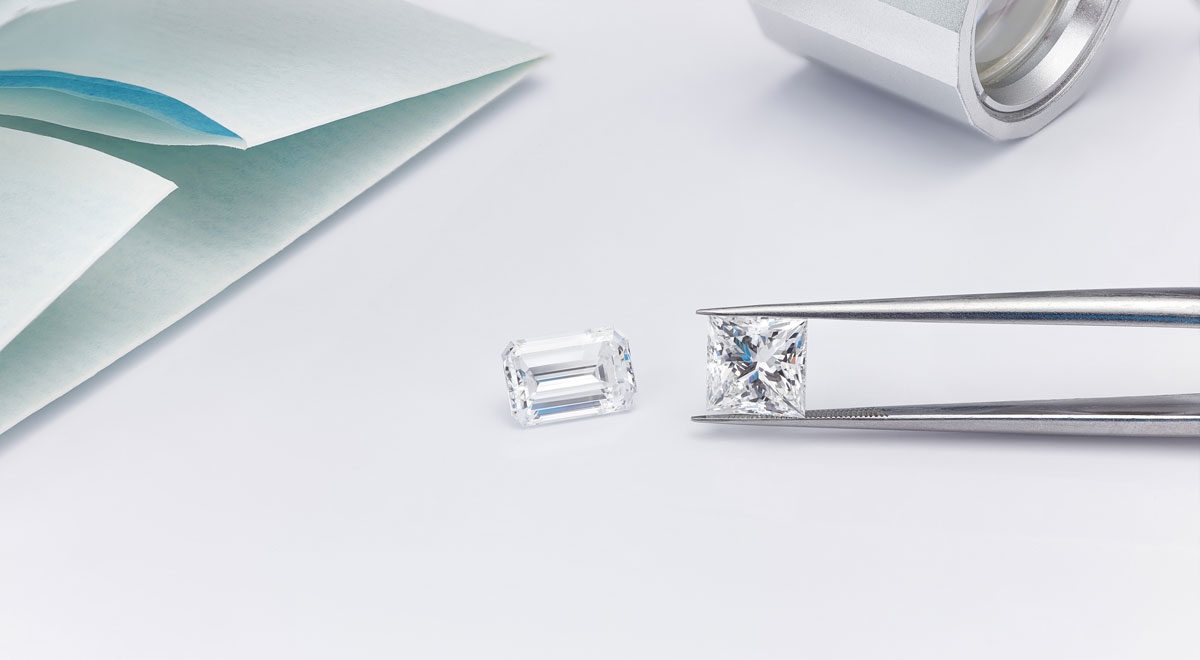Have you ever wondered why some diamonds sparkle more than others? Or why two diamonds of the same size can look so different?
The answer lies in the 4Cs – cut, colour, clarity, and carat – the universal standards for evaluating the characteristics of a diamond.
These four diamond qualities are the key to understanding a diamond’s value and beauty.
If you’re looking for a diamond that has a good balance of the 4Cs, this article is for you – we’ll delve deep into each of the 4Cs, explaining what they are, why they matter, and how to choose a diamond based on these crucial elements. We’ll also provide practical tips and insider knowledge to help you select the right diamond for your budget and preferences.
Let’s start by introducing you to what’s usually regarded as the most important of the 4Cs – diamond cut.
Understanding Diamond Cut
The cut of a diamond is a critical factor that greatly influences a diamond’s brilliance and overall aesthetic appeal.
Diamond cut refers not just to the diamond’s shape but to how well the diamond has been cut from its raw form, including facets, symmetry, and polish.
The Importance of Diamond Cut
The cut of a diamond is often regarded as the most important of the 4Cs because it has the greatest influence on a diamond’s sparkle. Even if a diamond has perfect colour and clarity, a poor cut can make it look dull and lifeless.
Conversely, a well-cut diamond can appear more brilliant and visually larger than its carat size might suggest.
To exemplify, here are two diamonds with the same colour, clarity, and carat weight, but with different cut grades. The first diamond has a ‘Good’ cut grade:
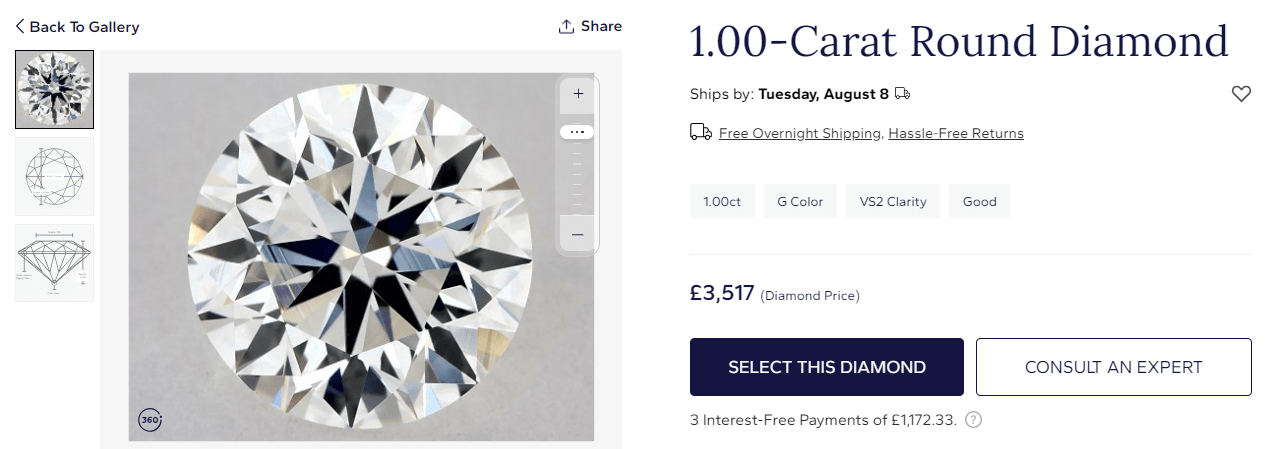
While the second diamond has an ‘Excellent’ cut grade:
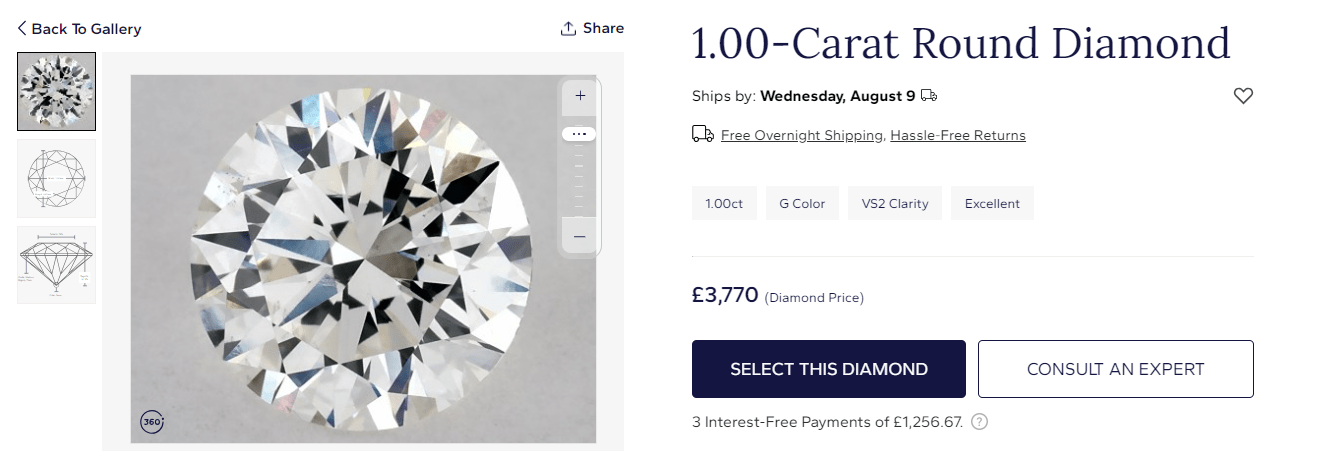
The diamond with the Excellent cut grade reflects light better, has more sparkle, and makes the diamond appear larger than the one with Good cut grade.
This illustrates the significant impact of cut on a diamond’s brilliance and perceived size.
The Different Types of Diamond Cuts
Diamond cuts can be broadly categorised into three types: brilliant, step, and mixed cuts.
- Brilliant cuts, like the round brilliant or princess cut, are designed to maximise a diamond’s sparkle.
- Step cuts, such as the emerald and Asscher cuts, offer a different kind of beauty, showcasing a diamond’s clarity with their large, open facets.
- Mixed cuts, like the radiant or cushion cut, combine elements of both brilliant and step cuts.
Each cut uniquely impacts a diamond’s appearance, influencing its brilliance, fire, and scintillation.
How Diamond Cut is Graded
The grading of a diamond cut involves a detailed analysis of the diamond’s proportions, symmetry, and polish.
- Proportions refer to the dimensions and angles of the diamond, which determine how well it can reflect light.
- Symmetry involves the alignment of the diamond’s facets. The more symmetrical the facets, the better the diamond can reflect light.
- Polish refers to the smoothness of the diamond’s surface. A high level of polish enhances the diamond’s light reflection.
The Gemological Institute of America (GIA) grades diamond cut on a scale from Excellent to Poor:
- Excellent (EX)
- Very Good (VG)
- Good (G)
- Fair (F)
- Poor (P)
Diamonds that rank ‘Excellent’ on this scale provide a high level of spark, brilliance, and fire. Conversely, Poor cut diamonds have steep pavilion angles and an overall dark and dimmed appearance.
Deciphering Diamond Colour
Diamond colour is another crucial aspect to consider when purchasing a diamond. It’s often regarded as the second most important diamond quality by diamond experts. It refers to the presence of any colour in a diamond, with the highest quality diamonds having no colour at all.
The Role of Colour in Diamond Quality
The colour of a diamond plays a significant role in its overall appearance and value. Diamonds with less colour allow more light to pass through and are therefore more brilliant. The less colour a diamond has, the higher its colour grade will be. That being said, the colour of a diamond can be more or less important depending on its cut and carat size.
The Diamond Colour Grading Scale
The diamond colour grading scale is a system developed by the Gemological Institute of America (GIA) to standardise the evaluation of diamond colour. This scale ranges from D, representing colourless diamonds, to Z, representing diamonds with noticeable light yellow or brown colour.
- D-F (Colourless): Diamonds in this range are the most desirable and valuable due to their rarity. They exhibit virtually no colour and allow maximum light to pass through, resulting in exceptional sparkle and brilliance.
- G-J (Near Colourless): Diamonds in this range may contain slight traces of colour, but it’s often challenging to detect unless compared side-by-side with diamonds of a higher colour grade. These diamonds provide an excellent balance of quality and value.
- K-M (Faint): Diamonds in this range have a faint yellow or brown hue, especially when viewed face down. However, when set in yellow gold or surrounded by other coloured stones, the colour may be less noticeable.
- N-R (Very Light): Diamonds in this range have a noticeable light yellow or brown colour. While not as valuable as higher colour grades, they can still be beautiful when properly cut and set.
- S-Z (Light): Diamonds in this range have a definite light yellow or brown colour. These diamonds are less commonly used in fine jewellery.
It’s important to note that the colour grade doesn’t necessarily reflect a diamond’s overall beauty. A well-cut diamond with a lower colour grade can often look more beautiful than a poorly cut diamond with a higher colour grade.
Choosing the Right Diamond Colour
There are several different factors to consider when picking the right diamond colour for you, including your budget, the setting of the diamond, and personal preferences.
- Budget Considerations: Diamonds in the colourless range (D-F) are the most expensive due to their rarity. If you’re working with a tight budget, you might consider a near-colourless diamond (G-J). These diamonds can offer excellent value for money as the slight colour is often not noticeable to the untrained eye, especially once the diamond is set in a ring.
- Setting Style and Metal: The colour of your diamond should complement the setting style and metal colour. For instance, colourless diamonds look stunning in white gold or platinum settings, which highlight their icy whiteness. Near colourless diamonds, on the other hand, can look beautiful in yellow or rose gold settings, which can mask any slight yellowish tones in the diamond.
- Diamond Size and Shape: Larger diamonds tend to show more colour, so if you’re opting for a larger carat weight, you might want to choose a higher colour grade. Similarly, some shapes like round brilliant cuts are better at hiding colour than others, such as emerald or Asscher cuts.
- Personal Preference: Some people prefer the icy white look of a colourless diamond, while others prefer the warmth of a slightly yellow diamond. It’s important to view diamonds in various colour grades in person, if possible, to determine what appeals to you most.
Remember, the goal is not necessarily to choose the diamond with the highest colour grade, but rather to find a diamond that appears white in its setting, is most pleasing to your eye, and balances well with the other 4Cs.
If you’re purchasing a diamond in the K-Z colour range, it’s best to opt for a yellow gold or a rose gold setting to help harmonise the yellow tint.
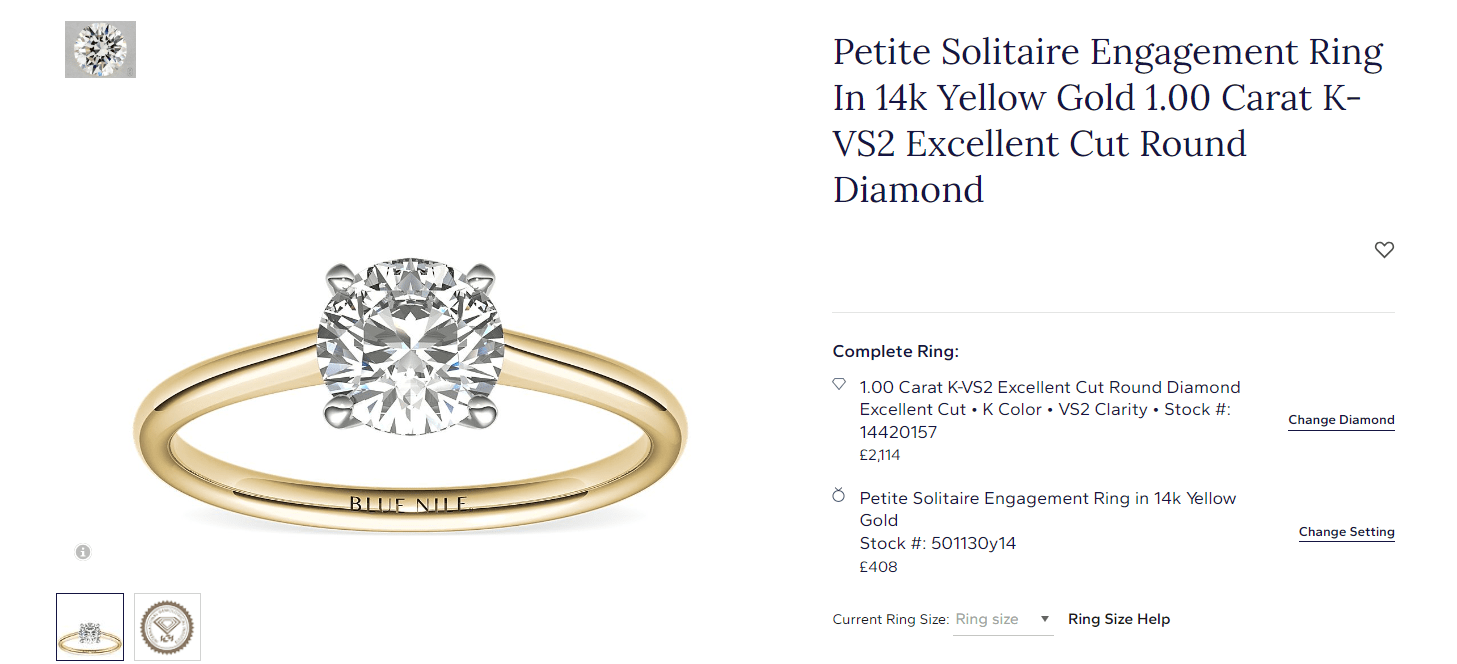
If you opt for a white gold or platinum setting, it can emphasise the yellow colour in the diamond.

Unraveling Diamond Clarity
Diamond clarity is another key factor in determining a diamond’s quality and value. It refers to the absence of inclusions and blemishes within the diamond, which are natural imperfections found within and on the surface of the diamond.
What is Diamond Clarity?
Diamond clarity is a measure of the purity and quality of a diamond based on the presence of inclusions and blemishes. Inclusions are internal characteristics or flaws, such as crystals, feathers, or clouds, while blemishes are external marks, like scratches or chips.
These imperfections can affect the path of light through the diamond, impacting its brilliance and overall appearance. However, many of these imperfections are microscopic and do not affect a diamond’s beauty to the naked eye.
The Diamond Clarity Grading Scale
The Gemological Institute of America (GIA) grades diamond clarity on a scale from Flawless to Included:
- Flawless (FL): No inclusions or blemishes visible under 10x magnification.
- Internally Flawless (IF): No inclusions visible under 10x magnification.
- Very, Very Slightly Included (VVS1 and VVS2): Inclusions so slight they are difficult for a skilled grader to see under 10x magnification.
- Very Slightly Included (VS1 and VS2): Inclusions are observed with effort under 10x magnification but can be characterised as minor.
- Slightly Included (SI1 and SI2): Inclusions are noticeable under 10x magnification.
- Included (I1, I2, and I3): Inclusions are obvious under 10x magnification and may affect the diamond’s transparency and brilliance.
Choosing the Right Diamond Clarity
Here are some things to keep in mind when deciding on a diamond clarity grade.
- Financial Considerations: Diamonds with higher clarity grades are more expensive. If you’re on a budget, consider a diamond in the VS or SI range, where inclusions are not typically visible to the naked eye.
- Diamond Size and Cut: Larger diamonds and certain cuts, like the step cut (emerald and Asscher), are more likely to show inclusions. In these cases, you might want to opt for a higher clarity grade.
- Personal Preference: Some people are comfortable with inclusions as long as they can’t see them without magnification, while others prefer a nearly flawless diamond. It’s important to view diamonds of different clarity grades in person, if possible, to determine what you’re comfortable with.
Remember, the goal is to choose a diamond that appears clean to the naked eye. Your diamond’s clarity should enhance its beauty, not detract from it.
Comprehending Diamond Carat Weight
Lastly, carat weight refers to the actual weight of the diamond and is often associated with its size.
What is Diamond Carat Weight?
Diamond carat weight is a standard unit of measurement that refers to the weight of a diamond, not its size. One carat is equivalent to 200 milligrams, or 0.2 grams. It’s important to note that carat weight can be misleading when it comes to the perceived size of a diamond. Two diamonds of the same carat weight can appear different in size depending on how they’re cut.
How Carat Weight Affects Diamond Appearance and Price
Carat weight significantly impacts the price of a diamond and its appearance. As carat weight increases, so does the size and cost of the diamond. However, the relationship between carat weight and size is not linear. For example, a 2-carat diamond is not twice the size of a 1-carat diamond, but it is significantly more expensive.
Take, for instance, these two round diamonds from Blue Nile – they have the same colour (G), clarity (VS2), and cut grade (Excellent). One of the diamonds is 1-carat:
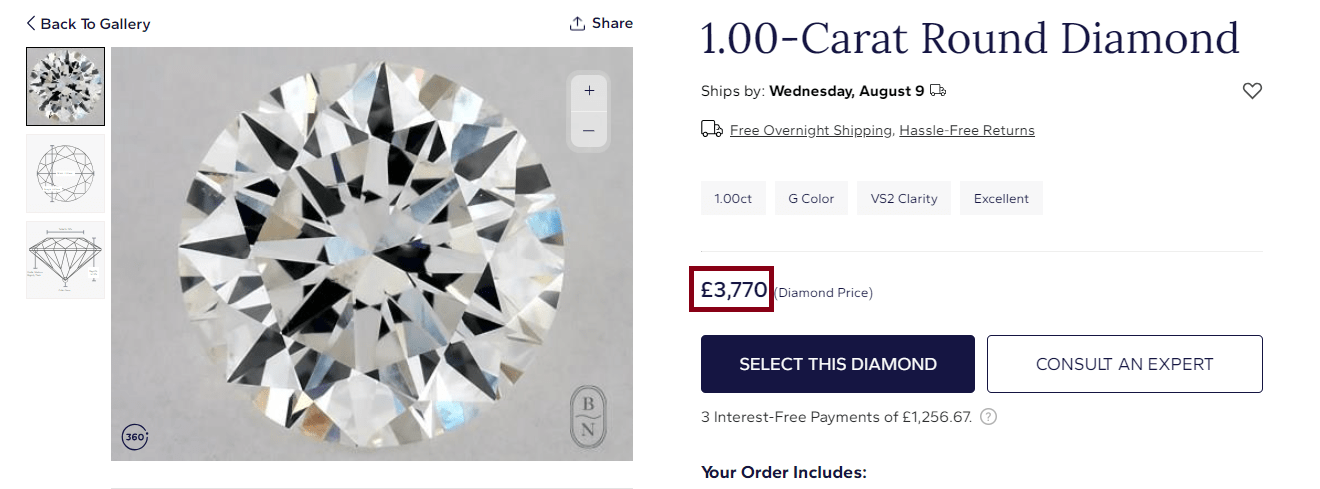
While the other is 2-carat:
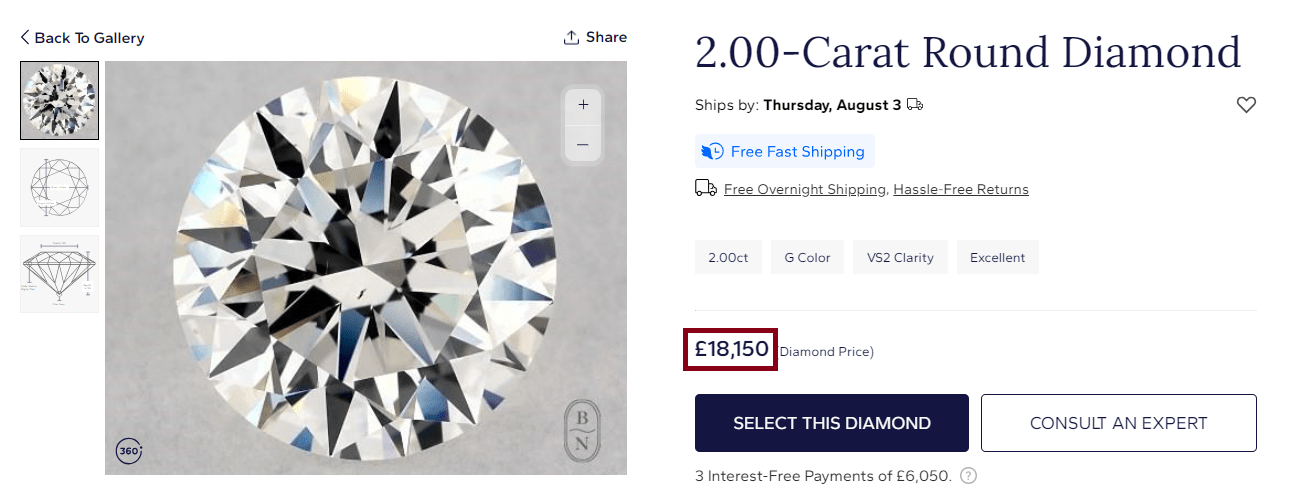
As you can see, the overall price difference comes to over £14,000.
Choosing the Right Diamond Carat Weight
Here are some pointers to consider when you’re choosing what carat weight to opt for.
- Budget: Diamonds increase exponentially in price as carat weight increases. If you’re on a budget, consider going slightly below popular carat weights (like 1 or 2 carats) for better value.
- Setting Style: The setting can make a diamond appear larger or smaller. For example, halo settings can make a smaller diamond appear larger, while a solitaire setting can highlight the size of a larger diamond.
- Preference: Some people prefer larger diamonds, while others value quality over size. It’s important to strike a balance between carat weight and the other 4Cs to ensure you’re getting a diamond that fits your preferences and budget.
Remember, the goal is to choose a diamond that fits your personal style and budget. Larger carat weight doesn’t always mean a better diamond. It’s the balance of all the 4Cs that determines a diamond’s beauty and value.
How to Choose a Diamond Based on the 4Cs (Keywords: choose a diamond, buy a diamond, engagement ring using the 4)
Choosing a diamond based on the 4Cs – cut, colour, clarity, and carat weight – is a crucial step in buying a diamond. It’s about understanding what each ‘C’ means, how it impacts the diamond’s appearance and value, and how to balance these factors to find the perfect diamond for your budget and preferences.
Step-by-Step Guide to Choosing a Diamond Based on the 4Cs
- Understand Your Budget: Before you start to look for diamonds, determine your budget. This will guide your choices when it comes to the 4Cs.
- Prioritize the 4Cs: Decide which of the 4Cs is most important to you. For most people, cut is the top priority as it has the greatest impact on a diamond’s brilliance.
- Choose Your Diamond Cut: Decide on the cut quality you want. Remember, a well-cut diamond will appear more brilliant and larger than a poorly cut diamond of the same carat weight.
- Select Your Diamond Colour: Choose a colour grade that suits your preferences. For most people, a near-colourless grade (G-H) offers the best value as any colour is virtually unnoticeable to the untrained eye.
- Decide on Diamond Clarity: Choose a clarity grade that offers the best value for your budget. For most diamonds, a clarity grade of VS2 or SI1 will appear clean to the naked eye.
- Determine Your Carat Weight: Finally, choose a carat weight that fits within your budget while meeting your size expectations. Remember, a larger carat weight doesn’t always mean a better diamond.
Tutorial: Using Online Diamond Inventory Tools
Online diamond inventory tools can be a great help in filtering diamonds based on the 4Cs. Here’s a step-by-step guide on how to use them:
- Enter Your Budget: Most tools will ask for your budget first. Enter your maximum budget to see what’s available.
- Select Your Preferred Cut: Choose your preferred cut from the options available. Remember, cut is the most important factor in a diamond’s brilliance.
- Choose Your Colour Grade: Select your preferred colour grade. If you’re unsure, near-colourless grades (G-H) are a safe bet.
- Select Your Clarity Grade: Choose your clarity grade. Remember, VS2 or SI1 grades will usually appear clean to the naked eye.
- Choose Your Carat Weight: Finally, select your preferred carat weight. Remember, carat weight is less about size and more about weight.
- Review Your Selections: The tool will display a list of diamonds that match your criteria. Review these options, paying attention to the price and any additional details provided.
Final Thoughts On The 4Cs of Diamonds
Understanding the 4Cs of diamonds – cut, colour, clarity, and carat weight – is an essential skill for anyone looking to buy a diamond. These four diamond qualities play a significant role in determining a diamond’s appearance, quality, and value.
Recap of the Importance of Understanding the 4Cs
The 4Cs provide a universal language for evaluating and comparing diamonds. By understanding these factors, you can make informed decisions about what you’re buying and ensure you’re getting the best value for your money.
- Cut determines how well a diamond reflects light and is considered the most important of the 4Cs.
- Colour refers to the presence of any colour in a diamond, with the most valuable diamonds being colourless.
- Clarity assesses the presence of internal or external flaws, known as inclusions and blemishes.
- Carat Weight measures the size of the diamond, but remember, bigger isn’t always better.
Whether you’re looking for the perfect engagement ring or a stunning piece of diamond jewellery, you can take into account these four diamond qualities to make informed decisions and find a diamond that fits your personal preferences and budget. Keep in mind that it’s not just about the technical details, but about using this knowledge to find a diamond that’s perfect for you.
Happy diamond hunting!
The 4Cs of diamonds refer to cut, colour, clarity, and carat weight. These are the four key characteristics used globally to classify and evaluate the quality of diamonds. The cut influences a diamond’s brilliance and sparkle, the colour grades its whiteness, clarity assesses the presence of internal or external flaws, and carat determines its weight.
The 4Cs of diamonds – cut, colour, clarity, and carat weight – are important because they provide a standardised method for assessing and comparing the quality of diamonds. Understanding the 4Cs is crucial as it helps you make an informed decision when buying a diamond, ensuring you get the best quality and value for your budget.
Absolutely, it’s possible to compromise on one or more of the 4Cs without significantly impacting the beauty of the diamond. For instance, you could opt for a diamond with a slightly lower colour or clarity grade, as differences are often not noticeable to the naked eye. However, it’s generally recommended not to compromise on the cut, as it has the greatest impact on a diamond’s brilliance and sparkle. It’s all about finding the right balance that suits your budget and personal preferences.
